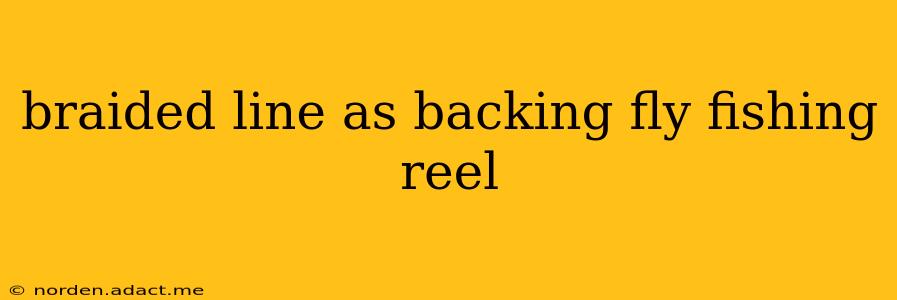Fly fishing often involves long casts and fighting powerful fish. This demands a substantial amount of backing on your fly reel to prevent spooling during those critical moments. While monofilament has traditionally been the go-to choice, braided line is increasingly popular as a backing material. This guide delves into the advantages and disadvantages of using braided line as backing for your fly fishing reel, helping you decide if it's the right choice for you.
Why Use Backing on a Fly Reel?
Before diving into the specifics of braided line, let's establish the importance of backing. Fly reels are designed to hold a limited amount of fly line. Backing provides the extra capacity needed to store the fly line when a fish takes off on a long run. Without sufficient backing, you risk losing your line, your fly, and potentially the fish. This is especially critical in situations where you are targeting large or strong fish.
What are the Advantages of Using Braided Line as Backing?
Braided line offers several compelling advantages as fly reel backing:
-
High Strength-to-Diameter Ratio: Braided line packs significantly more strength into a smaller diameter than monofilament. This means you can fit more backing onto your reel, increasing your overall capacity without sacrificing line strength.
-
Small Diameter: This smaller diameter translates directly to more capacity on your reel, crucial for anglers targeting larger species or fishing in situations where long runs are common.
-
Durability and Abrasion Resistance: Braided line boasts superior abrasion resistance compared to monofilament. This is particularly beneficial in situations where the backing might rub against the reel spool or other parts of the fishing equipment.
-
Low Stretch: Many braided lines offer very low stretch, which translates to better sensitivity and hook setting ability. While this isn't as critical for backing as it is for fly line, it can provide a more direct connection during long fights.
-
Variety of Colors: Braided backing is available in a wide array of colors, making it easy to visually distinguish between your backing and your fly line. This simple visual cue can aid in managing line during a fight.
What are the Disadvantages of Using Braided Line as Backing?
Despite its advantages, braided line also presents some drawbacks:
-
Potential for Knots: Braided line can be prone to knotting, especially when under tension during a fight. This is often considered its biggest drawback. Careful management and proper knot tying techniques are essential.
-
Less Smooth Casting: While the line itself is thin, the lack of stretch and its stiffness can sometimes make casting less smooth than with monofilament backing. However, this is usually negligible when considering the amount of backing used.
-
Higher Initial Cost: Braided line typically costs more than monofilament backing.
-
Can be difficult to manage: The strength of braided line can make it challenging to manage during a fight, potentially contributing to line tangles if not handled carefully.
How Much Backing Should I Use?
The amount of backing you need depends on the size of your reel, the diameter of your fly line, and the type of fishing you're doing. A good rule of thumb is to have at least twice as much backing as you have fly line. Always consult your reel's specifications for recommended backing capacity.
What Type of Knot Should I Use to Attach Backing to Fly Line?
Several reliable knots are suitable for joining braided backing to fly line. The most common and effective options include the Albright Knot and the Nail Knot. Mastering these knots is crucial for secure line connections.
Is Braided Line Better than Monofilament for Backing?
There is no universally "better" choice between braided and monofilament backing. The optimal choice depends on your individual fishing style, target species, and personal preferences. Braided line excels in situations requiring high strength and capacity, while monofilament is a more forgiving and often more economical option.
How Do I Spool My Reel with Braided Backing?
Spooling a reel with braided backing requires careful attention to avoid creating coils and loops. Use a backing bobbin or similar device to evenly distribute the line onto the spool, applying moderate tension throughout the process. Refer to your reel's instructions for specific spooling techniques.
By carefully considering the advantages and disadvantages and selecting the appropriate knot, anglers can harness the power and capacity of braided line as backing for improved fly fishing performance. Remember that practice makes perfect – spend time familiarizing yourself with the material and knotting techniques for optimal results.
